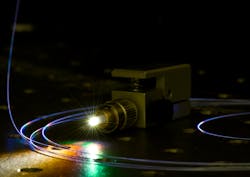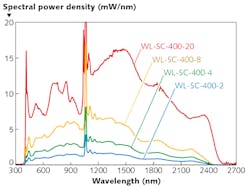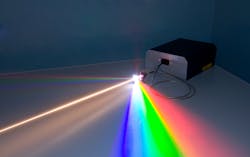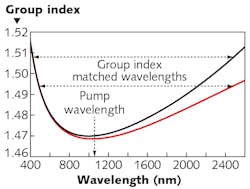Microstructured Fiber: Photonic crystal fibers advance supercontinuum generation
JAMES STONE, WILLIAM WADSWORTH, and TIM GERKE
It is now 20 years since the first reported photonic crystal fiber (PCF) was developed and it is easy to wonder if, in those early days, the effect that PCFs would have on nonlinear fiber optics could have been anticipated. With the promising features of PCFs such as air core guidance and the elimination of Rayleigh scattering for long-haul telecommunications, nonlinear fiber optics might have taken a back seat. However, today, the commercial success of PCFs is by far a nonlinear application in supercontinuum generation, with a current global market value of $25 million.A supercontinuum source provides an illumination that is radically different from any previous light source. A conventional bulb or LED lamp can provide a broad visible spectrum with a large spatial and angular spread, while a laser provides a collimated beam that can be focused to a micro-scale point, but usually with a very narrow spectrum. The outstanding attributes of both are combined in the broad spectrum and beam of a supercontinuum source (see Fig. 1). Inexpensive turnkey supercontinuum sources are available from several manufacturers where the supercontinuum is conveniently generated in the core of a flexible PCF (see image at the top of this).
The success of PCFs in supercontinuum generation is such that PCF-based supercontinuum sources are now commonplace in laboratories of all kinds across the world, and are finding new successes in OEM manufacturing. These are bought by customers who need no knowledge of the intricacies of nonlinear optics, PCFs, or the ultrafast lasers used as pumps, and it is to the credit of manufacturers that a supercontinuum source can be thought of as a box simply containing an exceptionally bright and broadband light source with excellent spatial qualities (see Fig. 2).Somewhat counterintuitively, the key to the success of PCFs in nonlinear optics is not through significant enhancement of the nonlinear properties of the fiber, neither has it been through any new guidance mechanisms since the fibers used for nonlinear study and applications are largely guided through total internal reflection. The breakthrough is in fact down to what can be done to the linear properties of the fiber—specifically, the control that PCFs give over the variation of refractive index and group index with wavelength, and how this can change the dispersion profile (β2).
Put simply, this control over the dispersion profile could never be achieved in conventional optical fibers. The importance of being able to control the dispersion can be seen from the dependence of most nonlinear equations on the linear parameter β2. From soliton dynamics to parametric four-wave mixing, nonlinear effects can be controlled in PCF like never before by altering the dispersion. In this article, we will discuss how varying different PCF parameters can change the generated supercontinuum, and contemplate how commercial supercontinuum sources may evolve in the future.
Role of group index and dispersion
Most current commercial supercontinuum systems rely almost completely on soliton dynamics. Here, we will describe in straightforward terms the formation of a supercontinuum and then highlight how PCFs have created or enhanced different elements, such as where the short wavelength edge is or the amount of power in the visible region of the spectrum. To start with, a powerful short pulse from an infrared (IR) laser, most commonly a ytterbium-doped, modelocked fiber laser or a Q-switched, neodymium-doped solid-state laser operating around 1060 nm, enters the supercontinuum PCF, which has been designed to have anomalous dispersion at this wavelength.
This short pulse breaks up into many fundamental solitons. This fission process is because of background noise, the Raman effect, or higher order dispersion, depending on the initial pulse duration. At the point of breakup, the solitons can emit radiation to a short wavelength resonance in the normal dispersion regime of the PCF—a process commonly known as dispersive wave emission or, alternatively, as the optical analogy of Cherenkov radiation.
The precise position of the short wavelength resonance is defined by the dispersion of the fiber, and the strength of the emitted radiation depends on how close the input pulse wavelength is to the zero-dispersion wavelength (ZDW). The closer the pump is to the ZDW, the more energy is transferred to the emitted radiation at the resonant wavelength. This point is important to be able to generate high power in the visible wavelength range from IR pump sources.
After pulse breakup and dispersive wave radiation, the solitons formed will shift to longer wavelengths through Raman self-scattering. This process generates the long wavelengths of the supercontinuum. In addition to moving to longer wavelengths, each soliton creates a localized nonlinear change in refractive index in the fiber through the Kerr effect. This localized variation will affect other light propagating in the fiber.
As the soliton frequency shifts to longer wavelengths, it becomes important to know what the group index profile of the fiber is. Commonly, the group index—which simply determines how fast a pulse of light will travel in the fiber—has a U shape with wavelength, the minimum of the U being the ZDW as dispersion relates to the derivative of the group index. This means that as the solitons travel to longer wavelengths, they slow down because of the increasing group index. As the initial pump light is launched close to the zero dispersion at the base of the U, the dispersive radiation on the short wavelength side of the ZDW is propagating at a similar speed to the solitons on the opposite arm of the U.
As the solitons slow down, they interact with any of the short-wavelength light traveling at the same velocity through the localized nonlinear change in refractive index, forcing it to become trapped and to propagate with the same group index. As the group index of the short wavelength light is forced to increase, its wavelength has to decrease. This process is known as group index matching and defines the short-wavelength edge of the supercontinuum. It is interesting to note that the short-wavelength edge of the supercontinuum therefore depends completely on the long-wavelength edge. The long-wavelength edge itself is usually around 2500 nm, caused by the large fundamental O-H absorption band centered on 2700 nm.
We now have three key points to note for fiber design. First, the pump must be in the anomalous dispersion regime to generate solitons that can self-frequency shift to create the long-wavelength edge. Second, the pump must be in close proximity to the ZDW to efficiently generate light at wavelengths lower than the pump. Third, the short-wavelength edge of the supercontinuum must match the long-wavelength edge in group index. So what does this mean for fiber design? We will look at two of the most common commercial PCF designs.
A solid-core PCF guides light through total internal reflection, forming an index contrast between the core and cladding through an array of air holes and lowering the refractive index of the cladding (see Fig. 3). The dispersion of an optical fiber has two components, one from the material and one from the fact that it is a waveguide.The choice here is clear: a lower wavelength, typically 400 nm over 450 nm, or higher power conversion from the pump to the visible regime. The small hole design also has a potential advantage that it is an endlessly single-mode PCF. It is possible for the initial dispersive-wave generation to create small amounts of short-wavelength light in different modes of the fiber, with a high spatial overlap with the fundamental core mode. In the small-hole case, these modes are not supported in the core and are quickly lost, whereas they can persist to the output of the large hole design as higher-order core modes.
What next for commercial sources?
Fibers with small variations on the structures discussed above form the basis of most current commercial systems, but other designs may offer better characteristics for future supercontinuum designs. One candidate for future sources is likely to be supercontinuum fibers with some variation along their length.
If favorable conditions for short-wavelength generation can be achieved at the PCF input and once this light is generated, the fiber properties change along their length to optimize group index matching, then superior performing systems are possible. An example of a tapered fiber that can achieve this is shown across the middle row of Fig. 3. The 6-μm-core, large-hole design shown on the left of Fig. 3 has a ZDW closer to the pump than the conventionally used large-hole, 4 μm core. However, the 6-μm-core design has poor group-index matching conditions. A 2-μm-core, large air-hole design, shown on the right of Fig. 3, has group-index matching conditions from around 300 to 2500 nm, but the ZDW is too far from the pump to generate any short-wavelength light in a uniform fiber.
Tapering across these designs from a 6- to a 2-μm core over a length of around 5 m has achieved ultraviolet (UV)-extended supercontinuum down to 320 nm. Problems with photodamage associated with UV generation may need to be overcome before these systems are released onto the market.
Supercontinuum systems based on soliton breakup are inherently incoherent with random pulse-to-pulse variation. PCFs can be made to generate coherent supercontinua using self-phase modulation alone if the dispersion profile is made all normal and flat around the pump wavelength. An example of a PCF with this dispersion profile is shown in the bottom row of Fig. 3. The supercontinuum generated by these systems is far narrower, but the coherence may open up potential new applications. Unlike the other supercontinuum systems discussed here, a modification to the standard commercial pump sources would be needed for these systems to be released into the market because efficient broadening through self-phase modulation requires pulses of a few hundred femtoseconds rather than several picoseconds or longer.
Work is far from complete on PCF and supercontinuum fiber laser development, and over the next two decades we can expect to see many new products and features: supercontinuum with high temporal coherence, extended bandwidth in silica fibers, and PCFs fabricated from non-silica glasses to extend spectra far into the IR. Finally, as the history of PCF has shown us, there will also be those exciting developments that we don't currently expect.
James Stone and William Wadsworth are affiliated with the Centre for Photonics and Photonic Materials at the University of Bath (England); e-mail: [email protected]; www.bath.ac.uk/research/centres/cppm, while Tim Gerke is sales and marketing manager, North America at Fianium, Eugene, OR; www.fianium.com.




